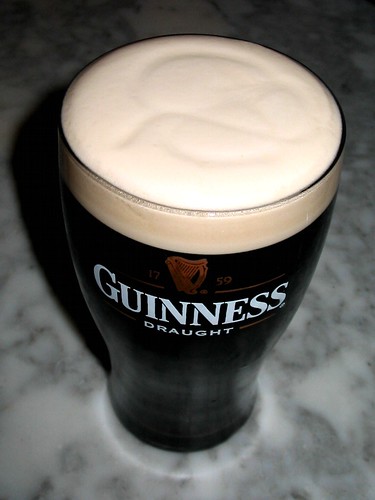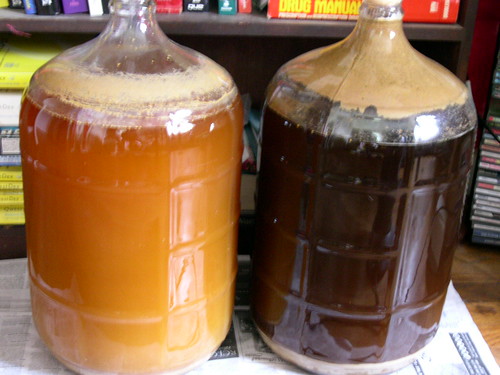 We all know one. There's one in every group. The "I don't like dark beer" person. This has always been a pet peeve of mine, and it's time I addressed it.
We all know one. There's one in every group. The "I don't like dark beer" person. This has always been a pet peeve of mine, and it's time I addressed it.I have a theory that when the average beer drinker says they don't like dark beer, what they really mean is that they don't like Guinness. Let me be frank, I love Guinness with a long-standing passion. I like the slightly acrid, burnt coffee bitterness, and the velvety, so-good-you-have-to-chew mouthfeel. It's far and away my favorite mass produced, near universally available beer. And when I say near-universally, I'm not blowing smoke; resident Punk globetrotter Mike can testify to the fact that Guinness is enjoyed ubiquitously everywhere around the world. But despite this, Guinness is not for everyone.
Consider toast for a moment. If you start out with bland, puffy white bread (say something with balloons on the label) and put it in the toaster for a little while, the sugars brown, and the flavor and texture become delightfully complex, at least comparatively speaking. I would venture to guess most people would say that humble white bread tastes better when toasted.
Now take that toast, put it back in the toaster, and turn the knob until it breaks off. When you come back, you will find a charred brick, whose delightful complexity has turned bitter and, for most people, unpleasant. You burned the toast.
What does this have to do with beer? The reactions taking place in the toaster are very similar to the reactions that take place in malt as it is kilned and/or roasted. All beer is made of malted grains, that is grains (like barley) that have been steeped in water, allowed to germinate, then kilned (or baked) to stop the process before the grain (which is really a seed) sprouts a new plant. This is true of light and dark beers alike; the difference between the two comes from what happens next.
 Some malts are kilned, or heated, longer or hotter than others. Heating sugars causes a complex set of chemical reactions known as the maillard reactions, similar to the ones that brown toast, steaks on a grill, or even dulce de leche for that matter. Depending on the environment in which these reactions take place, the resulting character of the malt could be described as anything from bready or biscuity all the way to dark fruit (plum or raisin) coffee or even chocolate. However they are carried out, though, the malt is darker, and so is the finished beer.
Some malts are kilned, or heated, longer or hotter than others. Heating sugars causes a complex set of chemical reactions known as the maillard reactions, similar to the ones that brown toast, steaks on a grill, or even dulce de leche for that matter. Depending on the environment in which these reactions take place, the resulting character of the malt could be described as anything from bready or biscuity all the way to dark fruit (plum or raisin) coffee or even chocolate. However they are carried out, though, the malt is darker, and so is the finished beer.Darker grains also make a less fermentable wort, because yeast is not equipped to process the complex sugars created by the maillard reactions. This means that a beer making generous use of darker malts will have more complex sugars dissolved in it after fermentation, giving it a more substantial body, greater malt complexity, and more residual sweetness. This residual sweetness also tends to make them less "crisp," as a crisp finish comes primarily from having a more fully fermented beer that has less residual sweetness to linger on the palate.
Beer is never (to my knowledge) made with all dark malt because the result would not be fermentable enough to be called beer, and would likely be oppressively acrid like the burnt toast I spoke of earlier. Dark beers use a lighter malt as the base (usually more than half of the total malt content) and the darker malts are used in smaller portions to add just an accent to the beer's flavor.
Now back to Guinness, and toast. Some people like Guinness, some people don't. Some people like their toast dark; some actually like it completely burnt. There really is no accounting for taste. But it is the very ubiquity of Guinness (it is actually the only dark beer many American consumers are ever exposed to) that turns many people away from dark beer, at least that's my theory.
Truly, much as I like it, Guinness and other dry stouts are at the harsh end of the dark beer spectrum. It has a bit of a tang to it; in the case of Foreign Extra Stout this comes from the fact that the brewers actually spoil a portion of the batch with bacteria to give it a vinegarlike flavor, then fold those portions back into the batch. Generally speaking Dry Irish Stouts include considerable amounts of unmalted roasted barley, which is roasted quite dark and lend the beer coffee notes and a dry bitterness that is characteristic of the style. Furthermore, according to Ray Daniels in Designing Great Beers, it is one of the most unbalanced styles in the world, with a low original gravity and relatively judicious IBUs, giving it a BU/GU ratio near 1.0. (See our previous post on IBUs for a discussion of balance and how it is measured).
So despite its rich complexity and 250 year old tradition of quality, Guinness is not for everyone. But the reader would do well not to let a bad experience with a single beer chase them away from the rich malty complexity of other dark beers. There are plenty of examples of styles that maintain the complexity of dark malt without sacrificing "drinkability" as one brewer would put it.
 So how can we help our friends get over their fears? As always it depends on their particular tastes.
So how can we help our friends get over their fears? As always it depends on their particular tastes.People who drink lighter colored craft beers in the British tradition (like pale ales and IPAs) would do well to dip their toes in with an amber ale. This is a great gateway beer for folks who are OK with full flavored beer and the fruity yeast aspects of other British ales, and it gives you a good helping of the bready, slightly toasted malt character dark beers have to offer without going too far beyond the familiar. If that works, try a brown ale next. They are roasted a bit darker still, bringing out some delightful nutty qualities in the malt. If I haven't lost you yet, try a Porter. There is a great variety within the style, so it's hard to really describe exactly what you can expect here. They tend to have all the dark complexity of a dry stout without the harsh bite, owing to a greater portion of pale base malt and more balanced BU/GU ratio (about 0.7-0.9 according to Ray Daniels).
Those whose taste leans to the lager side (which would include fizzy yellow stuff) want to think German. Any one of the darker German lager styles would be a good choice, since German beer is always, above all else, extremely drinkable, clean, and generally crisp. None of which generally comes to mind when the average consumer thinks of dark beer. But try a Munich Dark (Dunkel) or Black Beer (Schwarzbier) and you will change your mind quickly. In fact, schwarz in particular has always reminded me of Guinness with all of the sharp edges filed down. For something a bit more ambitious, try a Bock or Doppelbock; this is the boldest of all the German lagers with tons of delicious malt complexity and a high alcohol content, but they are still amazingly clean and easy drinking. Another safe bet that's very easy to find in decent liquor stores would be Negra Modelo, a dark lager first brewed in Mexico by Austrian immigrants.
And what about the grape juice drinkers? I always point wine people toward the Belgians...it's a long shot, as Belgian beers are very complex and might be offputting to casual beer drinkers, but if there's any chance of getting a wine person to drink beer, this is it. Quads are extremely complex, fruity strong dark ales; that's a good place to start. There are also many fruit lambics that are dark and would work quite well for wine people, such as Kriek (cherry) or Framboise (raspberry), though the darkness here is likely from the fruit, rather than the malt.
The various styles of dark beer cover alot of ground, and are largely unexplored by the average American beer consumer. This is not acceptable. The next time you hear someone claim to not like dark beer, don't just roll your eyes. Roll up your sleeves and show them the error of their ways. And if you fear the dark, please seek help. There is a better life waiting for you.





I tend to be one of those folks that shies away from darker brews. I attribute this to the fact that bitter isn't really one of my favored tastes, one of the main reasons I dislike coffee. However, I have found that while I can enjoy an occasional Guinness,I find Young's Double Chocolate Stout to be very enjoyable. The bitterness there is nicely balanced with a mellowing chocolate aftertaste, much like bittersweet chocolate. Also Sam Adams Cream Stout is a pleasure whenever I stumble upon one. I think you are right about the hardest thing for most people to get over is their preconceived notions of dark beer. It would be nice if we could all enter into new experiences without the bias of our own thoughts. Truth be told I think thats a problem everyone deals with in all facets.
ReplyDeleteAs usual, your comments are well articulated and much appreciated Birdman.
ReplyDeleteOne thing I was trying to get across here and I'm not sure how successful I was, is that dark beers aren't all bitter. The two examples of stouts you cite both fall under the category of sweet stout, rather than the dry irish stout category where Guinness resides. They tend to use far less hop bitterness, and the unfermented sugars juice up the sweetness (remember darker worts are less fermentable so there's actually more residual sweetness). Some even add lactose to the malt bill (these are called Milk Stouts) specifically because it is unfermentable. Ray Daniels places these at a BU/GU ratio of about 0.5, which is far more balanced than the dry stout.
Anyway, the bitterness in the dry irish stout category comes from the hops and how they are used (i.e. boiled to oblivion so all you get is bitterness...taste an IPA next to a dry stout if you want to see the difference between hops boiled for a long time versus a shorter time, the difference is most dramatic in this example. For an explanation as to why there is a difference refer to our article on IBUs). The darkness in dry stouts, however, comes from the malt, rather than the hops. Therefore bitterness and darkness are completely separable (though the high proportion of roasted barley in this particular case does add some dry bitterness that is often referred to as acrid).
As another illustration, consider that dark, rich Bock beers are quite sweet in balance, with a BU/GU around .35, where as the lighter colored IPA has one closer to the dry stout at about 0.7 to 0.9. It's all a matter of how much hops v. malt and how they are applied.